
Hello my loves, I'm back with another blog. I know there is so much of gap between the blogs and I swear I want to write more. Anyway, I thought what better way to get back at this with an Eco-printing blog.
When I googled 'Eco-Print', I saw a lot of articles regarding how to do it. But very few articles told me about the history of eco printing and how to identify different techniques that are used for 'eco-printing'.
So
What is Eco printing?
Eco printing, Eco dyeing, dyeing with flowers, flower dyes, there are so many names to it - you can call it what you want but the most accurate term for me is — eco-print, which was coined by the goddess of eco printing — India Flint (insert website), this lady has explored eco print in ways we can’t imagine. I feel all the different techniques of doing this craft falls under one name ---> Eco Print.
(Writing about India Flint reminded me that I should recommend some books to y'all. I'll write about this at the end of the blog.)
Past
Humans couldn’t figure the trace as to when did we discover eco print but the precursor of botanical printing would be naturalistic printing during the middle ages which were used by herbologists for medicinal purposes. They used to cut the plants and carry them in their books for reference purpose and identification.
Perfumery — also used a lot of naturalistic printing to keep a track of which plants are used for what fragrances and that makes me feel that it would have helped a lot in printing them on paper properly.
Naturalistic printing (google it) Naturalistic Printing, precursor of Botanical Printing was developed in the Middle Ages to assist medicinal herbologists (the earliest datable nature print dates from 1228) using relatively simple impressions taken from leaves and fruit. The first documented event of Nature Printing has been recorded in a Dioscorides Manuscript ‘De Materia Medica’ from 1228.

We teach about the history of eco printing in our workshop! To know more in depth you can register for it. We have an online as well as an offline workshop for it. Click here to know more!
I will be giving out a detailed blog regarding as to what all do you need when you begin eco printing in my next blog but till then we can go over some basics of eco printing.
The basic idea behind using such techniques is that we extract or transfer color from nature to a piece of paper or cloth and for that we hammer, press ,rub or resist the natural material on our cloth. And to secure the colour that we have extracted, we steam or boil this.
Bundle dyeing and Eco-printing are two different techniques
They give out their own colors in this. And we use steam and mordants to lock in this colours on the cloth.
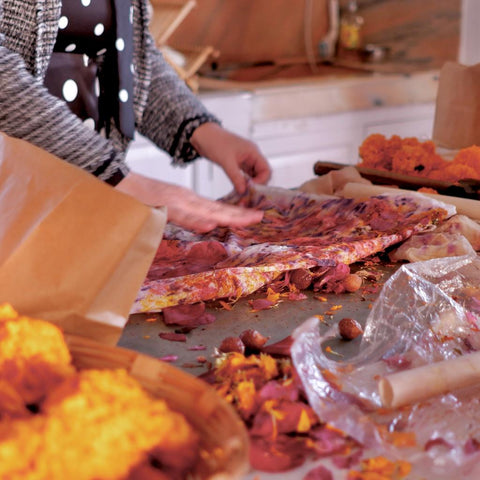
Some people steam it and some people boil these bundles, it is directly related to the type of effect we want in the result. Steaming gives out more concrete impressions, whereas. boiling out the entire bundle gives out a bleed effect.
More precise prints come through eco printing in which we flatten the flowers, leaves and other parts of the plants. In this case the prints are very very precise.
Let's jump into some eco printing techniques :
Hapazome:
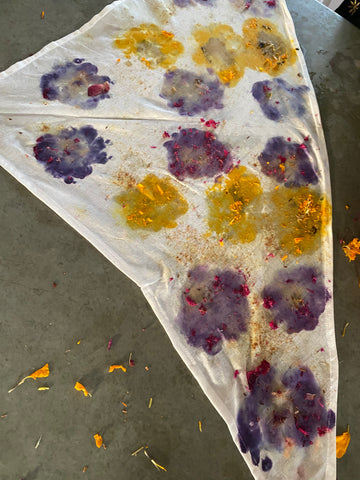
Quite literally meaning 'leaf dye', hapa-zome is the Japanese technique of smashing flowers and leaves into fabric. This gives out exact prints as you stamp the flower it imprints directly on the cloth. Flowers should be flatted before. This technique gives out very accurate prints.
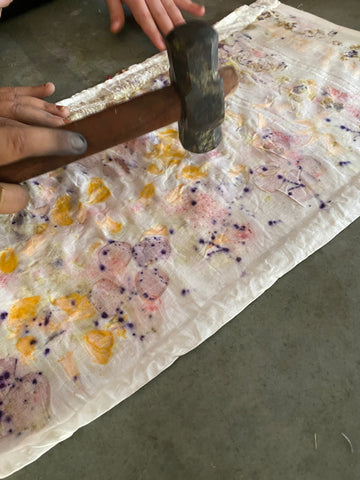
To secure the print in this case also it is important to steam the fabric.
I have made a lot of my products with this technique and I love working with this.
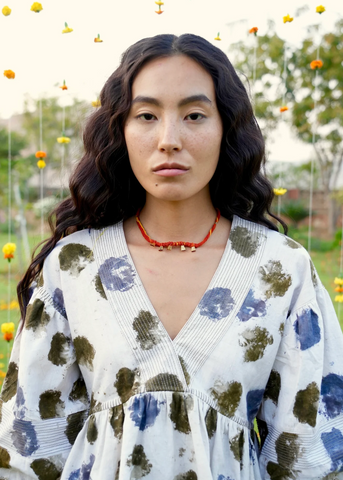 this particular top is made with marigolds and roses by hapazome or hammering.
this particular top is made with marigolds and roses by hapazome or hammering.
Direct Printing:
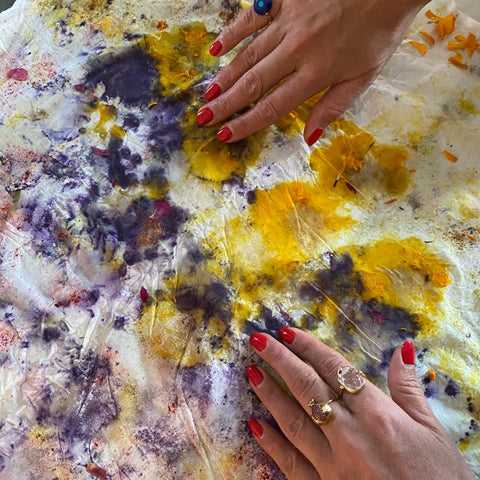
Flattening out the flowers or leaf and them giving out direct colors on the cloth with exact print, in this we extract color by tightly wrapping it around a stick or rod and then steam it. The pressure from rolling the cloth on the stick and the temperature in the pot will help the natural materials release its colour on the cloth.
The thing is that even the smallest of change, like in this case instead of hammering it we steam the part of the plants that we're using and it makes a huge impact on the final results.
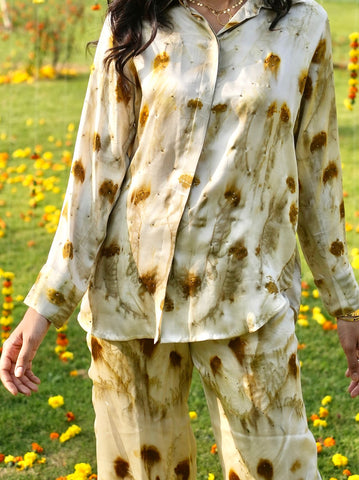 This is how marigold look when you steam them directly without hammering it on the cloth. This co-ord is also available at my e-store. The most lovely part about this set is that these marigolds are grown by my mother every year. Each year we come up with a small collection by printing the entire plant in ode to how much our mothers and Mother Nature provides.
This is how marigold look when you steam them directly without hammering it on the cloth. This co-ord is also available at my e-store. The most lovely part about this set is that these marigolds are grown by my mother every year. Each year we come up with a small collection by printing the entire plant in ode to how much our mothers and Mother Nature provides.
Blanketing:
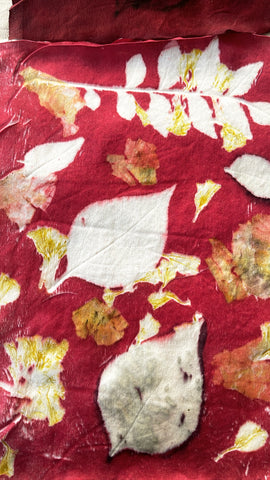
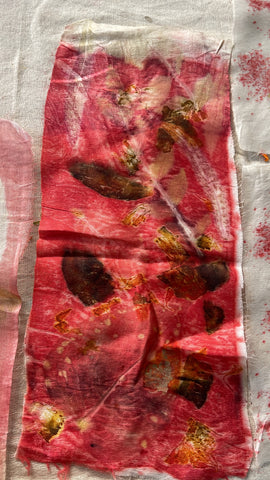
Technically the role of a blanket is to help the leaves not to bleed excessively. But there are times when the materials that we use do not release the colour directly from itself, we use these blankets to create resist with the leaves or flowers.
In this sample above (red/pink one), my blanket was dipped in a dye bath made from sappanwood. This blanket could have been dipped in iron and the target blanket can be of tannin (sample below). When they will come in contact, it will make the contact area completely grey or black.
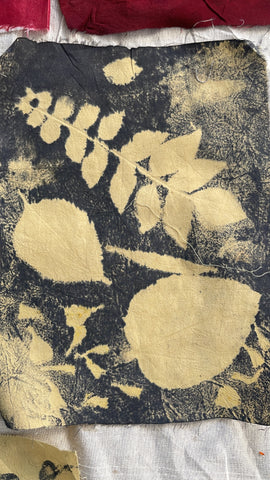
How?
You will have to understand the magic of how natural dyes work and how they react with each other. We use another piece of cloth that we dye in another dye bath or metallic salts to react on the target fabric. Wherever the leaves are present and they don’t give out colour. It will resist that shape and the other exposed part which is in direct contact with the blanket fabric which will react or release its colour or reaction on the target fabric. The photo attached at the bottom, this piece has been done with the blanketing method, by keeping the target and the blanket fabric in tannin and placing iron leaves in the middle so the reaction happens.

There are no specifications as to how many types of eco prints are there in the world because each eco print is unique and none are alike but it becomes a lil easy if you can identify the technique and then do something because even the exploration becomes intense and more focused.
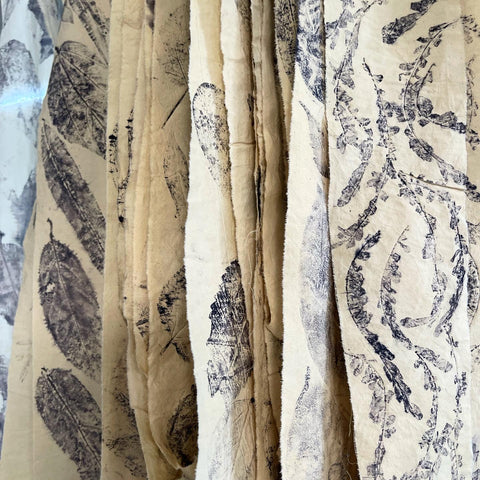
These are the three techniques that I have widely seen people use in the world of eco printing. There are so many permutations and combinations that you can work with and the possibilities are endless.
I love using this technique in my collections!
What's next?
Let's do a lil eco printing in the next blog! and I'm very excited to share some of my projects that I have been working on with eco-printing. Will be posting about them in my next blog! Let's try to make something out it! I'll be using an old t-shirt to print upon! You can look for something as well that you wanna give new life to! See you soon! we can do this maybe on instagram live together when I do the eco printing! ;)
Thank you,
Lots of Flowers,
HA.



2 comments
Thank you.
I inserted this post.
I live in Myanmar.I try this process.
See you again.
what a wonderfulnidea to write this blog with all the Indian plants we have. I Love India Flint and thecway she works.
How do we make sure we are able to get your blogs ? Please share where to find it and also whar is your insta name ?